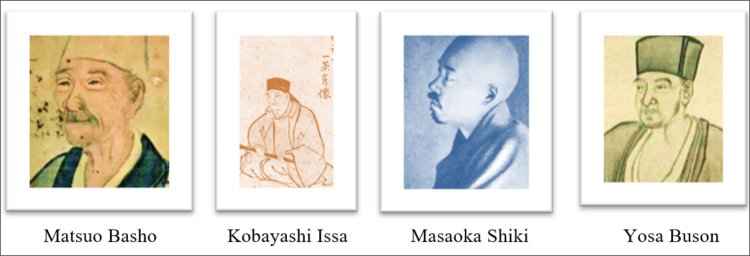HAIKU: A POETIC ART FORM
-Haiku is a short exquisite poetic art form which originated from Japan. These short poems are intended to be read in one breath. The beauty of this art form lies in the concrete sensory images it creates and the way it evokes the readers’ emotions.
-The seeds of haiku were planted in early 7th century in Japan, in the form of short lyrical narrative poems uta or songs. These were written as part of pre-Buddhist or early Shinto ceremonial rituals. The most popular of these forms was waka which featured 31 phonetic units, or ‘on’(means sound), broken into five lines by a 5-7-5-7-7 count. Officials and courtiers played proficiently with words in writing a waka. It became the most recognized poetic form of that period. Beginning in the 9th century, waka was refined and transformed into a very specific form and termed as tanka, a short song.
-The tanka followed the format of five-seven-five syllables and ended with two seven syllable lines. Here we need to emphasize that when we use the word syllables, Japanese syllables are different from English language syllables. These are ‘on’(sound), the phonetic units used in Japanese poetry.
-Later in the imperial courts, courtiers began to write renga following the same pattern of tanka as social pastime. Tanka was written by one author whereas, renga were collaborative pieces in which the guest started off with a ‘five-seven-five’ hokku stanza, followed by a second writer, normally the host, adding a "seven-seven" stanza. From there the stanzas were written in turn by the various members of the assembly.
-The hokku, starting verse following five-seven-five syllable lines separated from renga in the sixteenth century and later mastered by Matsuo Bashō. The Japanese writer Masaoka Shiki is said to have coined the term ‘haiku’ at the end of the nineteenth century.
-Japanese haiku has been influenced tremendously by four haiku masters known as "the Great Four:" Matsuo Basho, Kobayashi Issa, Masaoka Shiki, and Yosa Buson. Their work is still followed for writing a traditional haiku.
Matsuo Bashō’s, classic haiku ‘The Old Pond’ is among the best known Japanese haiku of all times.
Furu ike ya
kawazu tobikomu
mizu no oto
The literal translation of this haiku poem, by Robert Hass, is:
old pond . . .
a frog jumps in
water’s sound
Taken as an example this poem contains all the elements of traditional haiku. The original Japanese version consists of a total of 17 syllables with 5-7-5 syllables. There are two juxtaposed parts. Structurally, a haiku poem has a ‘kireji’ or cutting word to indicate their separation. Here, the cutting word ‘ya’ in the first phrase marks a shift in the poem. Another important element of haiku is ‘kigo’, a word or phrase associated with a particular season. Here kawazu (a small web-footed water animal) refers to frog. The frog is the ‘kigo’, a seasonal reference. In most Asian countries, frog is associated with monsoon season. But, here, Bashō describes the scene with no sounds except that of the pond water. So, the ‘kigo’ in this poem refers to the spring season.
-Another powerful haiku written by Katsushika Hokusai, a disciple of Bashō, is ‘A Poppy Blooms’. He uses imagery of the spring season to describe his writing process.
I write, erase, rewrite
Erase again, and then
A poppy blooms.
-Poppy is a seasonal reference to spring when things blossom. Through all the erasing and rewriting, the poet’s poem blooms like the blooming poppy. It has two juxtaposing images, and creates a sudden sense of enlightenment. In the original Japanese poem it conforms to the 5-7-5 sound structure.
-Originally from Japan, haiku today are written in major languages worldwide including Bangla. Haiku in English and in other languages have evolved their own styles and traditions, while still keeping most of the characteristics of the traditional haiku.
-As the stylistic haiku poem traveled west, prominent American writers like Ezra Pound picked up the craft. Ezra Pound’s ‘In a Station of the Metro’ is often considered the first haiku written in English, though it does not follow the 5-7-5 structure.
The apparition of these faces in the crowd;
Petals on a wet, black bough.
-Pound has beautifully juxtaposed the two vivid images here: “The apparition of these faces in the crowd: Petals on a wet, black bough.”
-The degree to which haiku in English resembles traditional Japanese haiku varies. But many of the poems have certain characteristics that are commonly associated with the genre. The styles incorporated in English haiku are discussed below:
-Traditionally, haiku is written in three lines, following 5-7-5 syllables. As discussed earlier there is a misinterpretation when we say syllables. The term syllable is “an inaccurate way of describing the actual metrical units of Japanese poetry.” (Shirane, 2000). Strictly speaking, Japanese syllables are different from English language syllables. For example, the word ‘haiku’ in English counts as two syllables (hi-ku), but three sounds in Japanese (ha-i-ku). The word ‘Christmas’, with two syllables, borrowed by the Japanese from English language is pronounced ‘ku-ri-su-ma-su. Some additional characteristics associated with English haiku, unlike the Japanese haiku, are three asymmetrical lines with 10-14 syllables to maintain conformity with the Japanese metrical units. The second line is usually the longest.
Another structural difference while translating is that Japanese haiku are sometimes written straight across in one line (sometimes horizontally, sometimes vertically) depending on the subject matter), while English-speaking poets use two line breaks to separate the poem into three lines.
There are two irregular sections which juxtapose two subjects (e.g. something natural and something human-made or two unexpectedly similar things.) In traditional haiku the poem uses kireji creating a sort of juxtaposition, grammatically as well as imagistically. The pair of two different images is put together in such a way that there is a leap between the two, yet there is a connection. The art of haiku lies in creating the right amount of contrast between the two parts, neither too vague nor too obvious. The relationship between these two parts is sometimes surprising, yet beautiful. Contemporary haiku may not always use a kireji, but juxtaposition remains a common feature of haiku.
Traditional haiku don’t use titles but in a few cases modern English haiku have titles.
Usually present tense is used to give the haiku a sense of immediacy.
There is a focus on nature or kigo a word or phrase that refers to a particular seasonal reference. Describing the season was the original purpose of haiku. Even now, poets often focus on the natural world and how it changes throughout the year. Portraying a season with only one word helps haiku with economy of expression. Some of the most classic kigo are sakura (cherry blossoms) for spring; fuji (Wisteria) for summer; tsuki (moon) for fall; and samushi (cold) for winter. Modern English haiku may not have a seasonal reference.
Deals with a personal memory or experience. Traditional haiku are objective, whereas English haiku may sometimes be subjective. A reflective or nostalgic tone is often visible.
A key technique is to write what caused the emotions, not the emotions. Vivid sensory images are used to describe the subject to evoke the same emotions in the reader.
-Flexibility helped haiku to evolve in different cultures. As a matter of fact, preferences became part of the poet’s style. However, in writing English haiku certain rules for punctuation or capitalisation are maintained as given below:
-Haiku, often, captures a moment in time, hinting on something that happened both before and after that moment. To help understand this context of time, many haiku poets start with a lowercase letter and avoid period at the end. This gives an open ended effect.
Haiku, normally, have fragmentary sentences and rarely complete sentences. Thus many poets start with lower case letter, with no period at the end suggesting to readers that these aren’t regular sentences but fragmentary sentences.
Proper nouns should be capitalised.
To help indicate the ‘cut’ between the two parts in the haiku, typically an ‘em’ dash (—) or an ellipsis ( . . . ) is used. The em dash implies that the two parts are happening at the same time. Don’t put spaces before or after em dashes. An ellipsis is three periods with spaces in between ( . . . ) It must also have a space at the start and end ( . . . ). Use commas only if they are used the way you would correctly use them in a sentence. If using an em dash is possible then avoid a comma (Welch, 2015).
Some poets use no punctuation at all, leaving the readers to interpret the grammatical independence of the poem’s two parts. Some poets indent one or more lines to indicate the cut or to create the desired poetic effects.
The word ‘haiku’ is both singular and plural. So there is no need to say haikus.
-These are the most common and recommended ways for punctuating haiku. However other choices can be adopted to create a particular desired poetic effect.
Interestingly, in writing haiku, following restrictions are normally maintained-
No titles, though in English haiku sometimes titles are used.
A haiku usually doesn’t rhyme.
Judgmental remarks like ‘beautiful, ‘kind’ are always avoided. Factual representations of imagery used.
Poetic devices like metaphor, simile and hyperbole aren’t used.
Vague, ambiguous, or wordy languages are avoided.
Describing an idea, story, or feeling aren’t part of traditional haiku. (some English haiku have these)
No complete sentences.
-Though, modern English haiku don’t necessarily cover natural subjects, celebration of nature is often present. These still focus on simple yet sensory language that creates a brief moment in time and a sense of discovery. Sometimes traditional rules are ignored. So whether one chooses to play by the traditional rules or select their own style is entirely up to the poet. Going beyond traditions is how creative writing forms evolve.
Haiku is an excellent poetic form to add to the creative work in literature.
I personally enjoy writing haiku in English. I composed one recently. Sharing it below:
seeds, buds, petals
flowers bloom on trees . . .
phoenix rises
The seeds of haiku are roaming freely in the beautiful nature around us; helping poets across the world to enrich the wonderful world of poetry.





